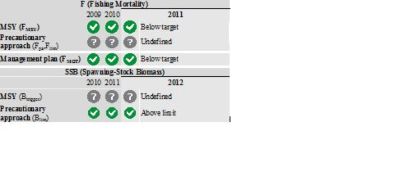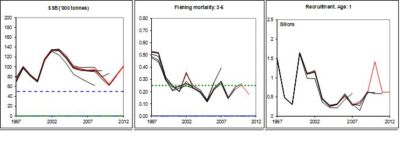|
| Fact Sheet Title Fact Sheet |
| |
| Herring - Northwest of Scotland |
 | Herring in Division VIa (North) |
| | Data Ownership | | This document provided, maintained and owned by International Council for the Exploration of the Sea (ICES) , is part of ICES Advice data collection. |
|
| ident Block | ident Block | | | | Species List: | | Species Ref: en - Atlantic herring, fr - Hareng de l'Atlantique, es - Arenque del Atlántico, ru - Сельдь атлантическая |
|
|
| ident Block Herring - Northwest of Scotland Map tips - Click on
 to turn layers on and off to turn layers on and off - Double-click to zoom in
- Drag to pan
- Hold down the shift key and drag to zoom to a particular region
| fao Div |
|---|
| 27.6.a | Northwest Coast of Scotland and North Ireland or as the West of Scotland (Division 27.6.a) |
|---|
|
|
|
|
|
| Aq Res | Biological Stock: Yes Value: Sub-Regional
Management unit: Yes Reference year: 2012
|
| Considered a management unit: An aquatic resource or fishery is declared as [Fishery] Management Unit if it is effectively the focus for the application of selected management methods and measures, within the broader framework of a management system. According to the FAO Glossary for Responsible Fishing, "a Fishery Management Unit (FMU) is a fishery or a portion of a fishery identified in a Fishery Management Plan (FMP) relevant to the FMP's management objectives." FMU's may be organised around fisheries biological, geographic, economic, technical, social or ecological dimensions , and the makeup and attribute of a fishery management unit depends mainly on the FMP's management objectives. |
| Jurisdictional distribution: Jurisdictional qualifier (e.g. "shared", "shared - highly migratory") of the aquatic resource related with its spatial distribution. |
| Environmental group: Classification of the aquatic resource according to the environmental group (e.g. pelagic invertebrate, or demersal fish) to which the species belong. |
| Reference Year: The Reference Year is the last year considered in the stock assessment and/or fishery status. |
| | | | | | Aq Res State Trend  | Figure 5.4.30.1  |
ICES considers that the stock over recent years has been fluctuating at a low level. Fishing mortality has fluctuated around F MSY in recent years. The current recruitment is lower than in the historical period. Habitat Bio Depth Zone: Shelf (50 m - 200 m). Vertical Dist: Pelagic. This autumn-spawning stock is considered a part of the Malin Shelf stock complex. Components of the neighbouring herring stocks to the south are known to be present seasonally in Division VIa (North). Studies in the acoustic survey are ongoing to evaluate the level of mixing. Spawning and nursery areas are sensitive and vulnerable to anthropogenic influences. Gravel extraction or disturbance in the close vicinity of any herring spawning will disturb that spawning activity and will reduce the area available for successful spawning. Environmental influence on the stock Temperatures and salinity in this area have been increasing over recent decades. It is known that similar environmental changes have affected the North Sea herring. Productivity of the Division VIa (North) stock has been reduced since the late 1980s. Geo Dist Geo Dist: Shared between nations Water Area Overview Spatial Scale: Sub-Regional Ecoregion: Celtic Seas. Water Area Overview  | | Water Area Overview Herring - Northwest of Scotland
| fao Div | 27.6.a: Northwest Coast of Scotland and North Ireland or as the West of Scotland (Division 27.6.a) |
| | | | | | Water Area Overview |
Water Area OverviewHerring - Northwest of Scotland | fao Major | 27: Atlantic, Northeast | | Large Marine Ecosystem Areas (LME) | 22: North Sea | | 24: Celtic-Biscay Shelf | | 60: Faroe Plateau |
Aq Res Struct Biological Stock: Yes Exploit The fisheries The fishery is conducted by single and pair Refrigerated Sea Water (RSW) trawlers and single-trawl freezer trawlers. Prior to 2006 there was a fairly even distribution of effort, both temporally and spatially. Since 2006 the majority has been fished in the northern part of Division VIa (North) in the 3 rd quarter. | Catch distribution | Catch (2011) = 17 759 t (50% pelagic freezer trawlers and 50% pelagic RSW trawlers). | Effects of the fisheries on the ecosystem Herring fisheries tend to be clean with little bycatch of other fish. Scottish discard observer programmes since 1999 indicate that discarding of herring in these directed fisheries are at a low level. These discard observer programmes have recorded occasional catches of seals and zero catches of cetaceans. Bio Assess Sci Advice ICES advises on the basis of the agreed West of Scotland herring management plan that landings in 2013 should be no more than 27 480 t. ICES advises that activities that impact on the seabed should not take place in spawning grounds unless they can be shown not to have a negative impact on spawning, larval production, or stock dynamics. Results  | Figure 5.4.30.1 Herring in Division VIa (North). Summary of stock assessment (weights in thousand tonnes). Estimates are shaded. Top right: SSB and F over the time-series used in the assessment.  |
Assess Models Quality consideration The assessment is considered to be noisy, but unbiased. Area misreporting continues to be a problem, with almost all countries taking catches of herring in other areas and reporting it into Division VIa (North). However, routine use of VMS has reduced the problem. Minimum sampling requirements are met in some quarters of the fishery. Samples from all quarters where there is fishing activity would improve allocation of sampled métiers in the stock-raising process.  | Figure 5.4.30.2 Herring in Division VIa North. Historical assessment results (final-year recruitment estimates included).  |
Scientific basis | Assessment type | Age-based analytical (FLICA). | | Input data | One acoustic survey index (MSHAS_N); commercial landings data. | | Discards and bycatch | Not considered relevant. | | Indicators | None. | | Other information | Last informal full range of model settings tested in 2009. | | Working group report | HAWG | Management Management unit: Yes Management plans A management plan has been adopted by the EU in 2008 ( Council Regulation (EC) 1300/2008, Annex 5.4.30). The main aim of the plan is to manage the fisheries on the basis of maximum sustainable yield. ICES has evaluated the plan and concludes that it is in accordance with the precautionary approach. Sources The above excerpts are from the first two pages of the ICES advice, the supporting information to this advice can be read in full at the following reference: ICES. Herring in Division VIa (North). Report of the ICES Advisory Committee, 2012. ICES Advice, June 2012.  http://www.ices.dk/committe/acom/comwork/report/2012/2012/her-vian.pdf http://www.ices.dk/committe/acom/comwork/report/2012/2012/her-vian.pdf |
|
| |
|





